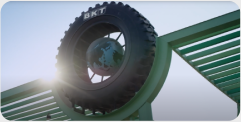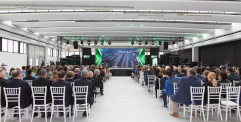It is important to have the right tire for the job for a plethora of reasons - not least both safety and efficiency. The tread of the tire helps meet these requirements. Each manufacturer has its own unique designs that they think will best fit the user's needs and allow the machine in use to work to the best of its ability. Discover our expert guide on all the tire tread terminology you need to know!
It is important to have the right tire for the job for a plethora of reasons - not least both safety and efficiency. The tread of the tire helps meet these requirements. Each manufacturer has its own unique designs that they think will best fit the user's needs and allow the machine in use to work to the best of its ability. From garden lawn mowers to industrial machines for farms and construction, having the correct tread is critical.
What is Tread & What Does It do?
The tread of the tire is that zig-zag pattern you think of when you picture a classic standard-issue tractor. It gives you traction, hence the name. It is the first contact with the land and increases the surface area to add grip and reduce soil compaction, which can harm yields. The types of tires needed for specialist jobs are designed by experts, from your garden lawn mower to the most sizable crane or bulldozer.
Agricultural, Industrial, OTR
There are three main types of tires. They are agricultural, industrial, and OTR.
- Agricultural tires are for farmers or contractors who need reliable tires to get the most out of their farming equipment for a variety of farming practices. Farms have a variety of needs that tires need to meet: from transport on road to farming activities; from decreasing soil compaction to specialized field works, and so on.
- Industrial tires are more made for carrying/loading, lifting and material handling with an emphasis on safety and stability on an industrial site (e.g. a forklift, carrier crate sites, airports, and more).
- OTR tires are for mining, construction and the most challenging sectors on earth, so the tire requirements of the tire need to match. They are built for strength, durability, and longevity.
Common Terms and Definitions
- R1 and R1W are for all things field-related, and can be found on machines such as tractors. Their tread allows for efficient traction on dry or muddy land. R1W has deeper tread than R1. The type of tire to use will depend on the soil conditions; R1W, for example, is more for the wetter and softer days.
- R2 tires are similar to the above but much deeper. They are utilised for the wetter and more extreme conditions, so they are useful for floods or rice and cane farms, for example.
- R3 shallow tread tires are designed to spread out the machine's weight more evenly across wider tires. The aim is to create a lovely finish to the turf—that crisp finish you see on cricket and football pitches. The wide surface and shallow depth of the tread are designed to keep the turf in the best condition with no marks. These are most likely to be found on your lawn mower or golf cart. You’ll, of course, not use the tires fit for a farm as that would leave big zig-zags in your lawn!
- R4 industrial tires are for your industrial needs. Think warehouses, forklifts, telehandlers and backhoe loaders.R4 industrial tires are designed to be broad and durable on surfaces made of concrete or gravel - roads and pavements etc.
Other Types of Tread:
Front tires
These are what are usually on the front of your tractor (most likely a 2-wheel drive) and implement machinery. For your agriculture tires, there are F1 (drier land), F2 & F2M (more wet and soft lands). These are designed to add to grip and self-clean, assist in steering control and work in harmony with your R1 tires, which we discussed earlier. These tires - known as rib tires - are perfect for operations that require specialist handling. ‘Ribs’ are the mini grooves that go around the whole circumference of the tire.
For the industrial tractor, there is the F3 tire; flatter than the above, they are a better fit for your roads and hard surface concretes and sophisticated handling needs.
OTR tires
OTR tires come in a variety of shapes, sizes, and types. OTR tires stand for Off The Road and are built for large machines for mining and construction, where you’ll find the toughest and most rough surfaces. These tires range from very tractive patterns to completely smooth patterns. They depend on the specific task they’re designed for, and come with letters that define the type of service such as Compactor [C], Grader [G], Earthmover [E], and Loader/Dozer [L].
Examples of OTR tires:
-
E2, G2, and L2 tires are built for traction and stability.
-
E3, G3, and L3 are designed for less demanding conditions and not critical applications.
-
E4 and L4 have a deeper tread, which helps to minimise the damage from rough and sharp lands, subsequently increasing tire life.
-
L5 are designed for more critical applications where the best protection against rocks and cuts is needed. They feature an extra deep tread that guarantees increased durability.
-
E7 have shallow treads or ‘ribs’ which are designed for loose surfaces such as sand.
As you can see, there isn’t really a “one tire fits all” motto to be followed. It is essential to have the correct tire for the specialist job at hand for efficiency and safety. For the whole catalogue and varieties of tires BKT has to offer, click here.
To keep up to date with all exciting updates with BKT and the news within the industry, connect with us here!






